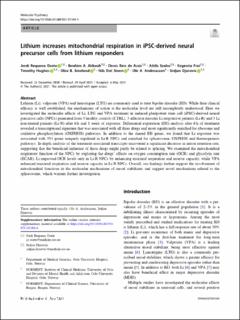| dc.contributor.author | Osete, Jordi Requena | |
| dc.contributor.author | Akkouh, Ibrahim | |
| dc.contributor.author | Reis de Assis, Denis | |
| dc.contributor.author | Szabo, Attila | |
| dc.contributor.author | Frei, Evgeniia | |
| dc.contributor.author | Hughes, Timothy | |
| dc.contributor.author | Smeland, Olav Bjerkehagen | |
| dc.contributor.author | Steen, Nils Eiel | |
| dc.contributor.author | Andreassen, Ole Andreas | |
| dc.contributor.author | Djurovic, Srdjan | |
| dc.date.accessioned | 2021-08-25T06:57:51Z | |
| dc.date.available | 2021-08-25T06:57:51Z | |
| dc.date.created | 2021-06-20T22:17:54Z | |
| dc.date.issued | 2021 | |
| dc.identifier.issn | 1359-4184 | |
| dc.identifier.uri | https://hdl.handle.net/11250/2771067 | |
| dc.description.abstract | Lithium (Li), valproate (VPA) and lamotrigine (LTG) are commonly used to treat bipolar disorder (BD). While their clinical efficacy is well established, the mechanisms of action at the molecular level are still incompletely understood. Here we investigated the molecular effects of Li, LTG and VPA treatment in induced pluripotent stem cell (iPSC)-derived neural precursor cells (NPCs) generated from 3 healthy controls (CTRL), 3 affective disorder Li responsive patients (Li-R) and 3 Li non-treated patients (Li-N) after 6 h and 1 week of exposure. Differential expression (DE) analysis after 6 h of treatment revealed a transcriptional signature that was associated with all three drugs and most significantly enriched for ribosome and oxidative phosphorylation (OXPHOS) pathways. In addition to the shared DE genes, we found that Li exposure was associated with 554 genes uniquely regulated in Li-R NPCs and enriched for spliceosome, OXPHOS and thermogenesis pathways. In-depth analysis of the treatment-associated transcripts uncovered a significant decrease in intron retention rate, suggesting that the beneficial influence of these drugs might partly be related to splicing. We examined the mitochondrial respiratory function of the NPCs by exploring the drugs’ effects on oxygen consumption rate (OCR) and glycolytic rate (ECAR). Li improved OCR levels only in Li-R NPCs by enhancing maximal respiration and reserve capacity, while VPA enhanced maximal respiration and reserve capacity in Li-N NPCs. Overall, our findings further support the involvement of mitochondrial functions in the molecular mechanisms of mood stabilizers and suggest novel mechanisms related to the spliceosome, which warrant further investigation. | en_US |
| dc.language.iso | eng | en_US |
| dc.publisher | Springer Nature | en_US |
| dc.rights | Navngivelse 4.0 Internasjonal | * |
| dc.rights.uri | http://creativecommons.org/licenses/by/4.0/deed.no | * |
| dc.title | Lithium increases mitochondrial respiration in iPSC-derived neural precursor cells from lithium responders | en_US |
| dc.type | Journal article | en_US |
| dc.type | Peer reviewed | en_US |
| dc.description.version | publishedVersion | en_US |
| dc.rights.holder | Copyright the authors 2021 | en_US |
| cristin.ispublished | true | |
| cristin.fulltext | original | |
| cristin.qualitycode | 2 | |
| dc.identifier.doi | 10.1038/s41380-021-01164-4 | |
| dc.identifier.cristin | 1917096 | |
| dc.source.journal | Molecular Psychiatry | en_US |
| dc.identifier.citation | Molecular Psychiatry. 2021. | en_US |

